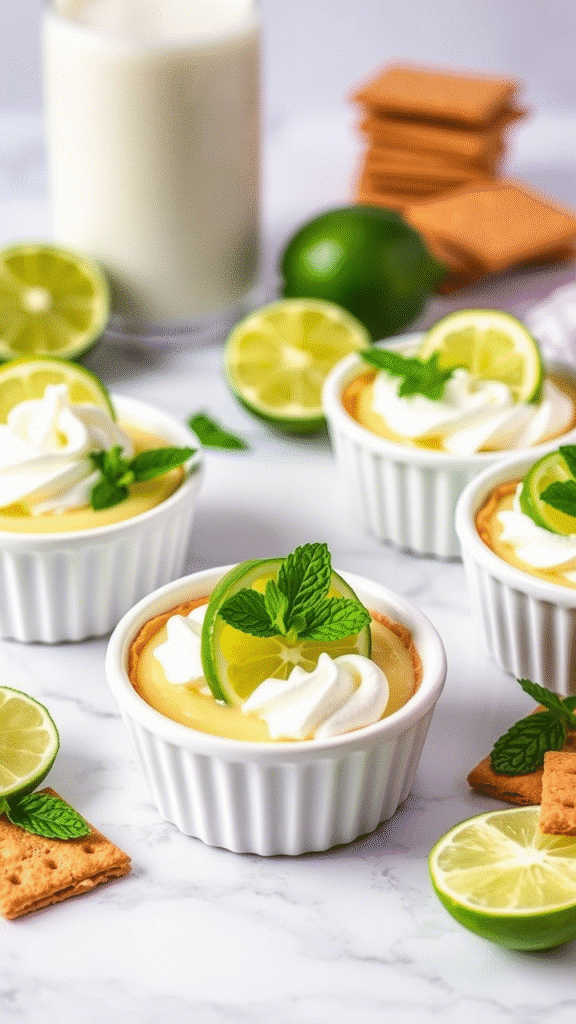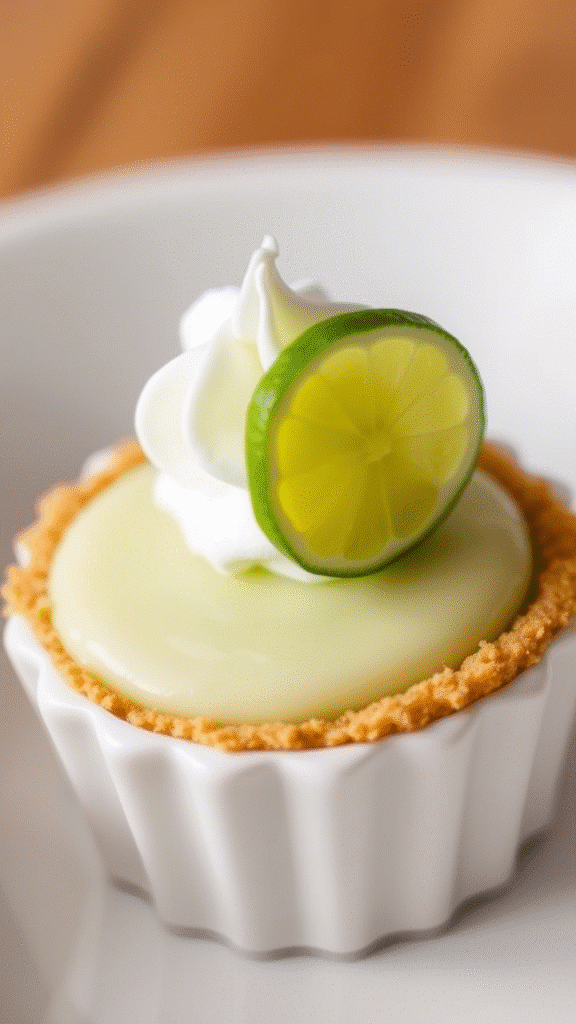I’ll never forget the first time I tasted an authentic Key lime pie in a tiny diner outside Marathon, Florida. The owner, a weathered fisherman turned baker, served it with a knowing smile and said, “This here’s the real deal no green food coloring, no shortcuts.” That pale yellow slice changed everything I thought I knew about this iconic dessert.
The true Key lime pie is deceptively simple yet maddeningly precise. It’s a testament to the power of three ingredients working in perfect harmony: egg yolks, sweetened condensed milk, and the juice of actual Key limes. When you transform this classic into no-bake mini versions, you’re not just making dessert you’re creating edible poetry that captures the essence of the Florida Keys in every bite.
What makes these mini no-bake Key lime pies extraordinary isn’t just their convenience. The individual portions allow for perfect custard-to-crust ratios, while the no-bake method preserves the bright, acidic punch that makes Key lime pie so distinctive. Each bite delivers that characteristic tangy-sweet balance that should make your cheeks pucker just slightly before the cream soothes your palate.
Ingredients & Substitutions
For the Graham Cracker Crust:
- 1½ cups graham cracker crumbs (about 12 full crackers)
- ⅓ cup granulated sugar
- 6 tablespoons unsalted butter, melted
- Pinch of kosher salt
For the Key Lime Filling:
- 1 (14-ounce) can sweetened condensed milk
- ½ cup fresh Key lime juice (about 25-30 Key limes)
- 1 tablespoon Key lime zest
- 3 large egg yolks
- 1 cup heavy cream
- 2 tablespoons powdered sugar
For Garnish:
- Lime zest curls
- Toasted coconut flakes (optional)
- Whipped cream rosettes
The foundation of any great Key lime pie lies in the limes themselves. True Key limes (Citrus aurantifolia) are smaller, more acidic, and possess a distinctive floral note that Persian limes simply cannot replicate. If Key limes are unavailable, you can substitute with a mixture of fresh lime and lemon juice use ⅓ cup lime juice plus 3 tablespoons lemon juice. This won’t be traditional, but it’ll deliver better results than bottled Key lime juice, which often tastes flat and artificial.
For the graham crackers, I prefer to crush my own rather than buying pre-made crumbs. The texture is more varied, and you can control the fineness. Pulse whole crackers in a food processor until you achieve a mixture of fine crumbs with some slightly larger pieces this creates a more interesting textural contrast.
The sweetened condensed milk acts as both sweetener and thickener in this recipe. Its high sugar content and pre-cooked nature allow the filling to set without baking. Don’t substitute regular condensed milk or evaporated milk; the chemistry won’t work properly.
Heavy cream should be at least 35% fat content for proper whipping. If you’re in a pinch, you can use whipping cream, but avoid half-and-half or milk they won’t provide the richness needed for the filling’s luxurious mouthfeel.
Step-by-Step Instructions

Preparing the Crust:
Start by preheating your oven to 350°F (175°C), even though this is a no-bake recipe. We’ll pre-bake the crusts for structure and flavor development.
Combine graham cracker crumbs, sugar, and salt in a medium bowl. The salt is crucial it brightens the graham flavor and prevents the crust from tasting flat. Pour in the melted butter gradually while stirring with a fork. The mixture should hold together when squeezed but not feel soggy.
Press the mixture firmly into mini tart pans or a muffin tin lined with paper liners. Use the bottom of a small glass or measuring cup to ensure even distribution and proper compaction. The crust should come up the sides about ¼ inch.
Bake for 8-10 minutes until the edges are golden brown and the crust feels set. This step is non-negotiable unbaked crusts will dissolve when the filling is added. Allow to cool completely before filling.
Creating the Perfect Filling:
In a large bowl, whisk the egg yolks until they’re pale and slightly thickened. This step aerates the yolks and creates a smoother final texture. Don’t skip this whole eggs or inadequately whisked yolks will create a grainy filling.
Slowly pour in the sweetened condensed milk while whisking continuously. The mixture should be smooth and uniform. Add the Key lime juice gradually if you dump it in all at once, the acid can cause the milk proteins to seize up and create lumps.
The magic happens when the citric acid from the limes begins to thicken the mixture. You’ll notice it becoming more viscous within minutes. This is the traditional “cooking” method that eliminates the need for baking. Stir in the lime zest now it provides textural interest and intensifies the lime flavor.
Whipping the Cream Component:
In a separate bowl, whip the heavy cream with powdered sugar until soft peaks form. Don’t overwhip you want billowy, not stiff peaks. The cream will continue to thicken as it sits, and overly stiff cream will create a dense, unappetizing texture in the final dessert.
Gently fold one-third of the whipped cream into the lime mixture to lighten it. This technique, called “tempering,” prevents the cream from deflating when you add the remaining portion. Fold in the rest of the cream using a rubber spatula, cutting down through the mixture and folding over. Stop as soon as no white streaks remain visible.
Assembly and Setting:
Divide the filling evenly among the prepared crusts. A small ice cream scoop or large spoon works perfectly for this task. The filling should come to just below the rim of each crust—resist the urge to overfill, as the mixture will expand slightly as it sets.
Refrigerate for at least 4 hours, though overnight is preferable. The filling needs this time to fully set and develop its characteristic tangy-sweet flavor profile.
Cooking Techniques & Science
The science behind no-bake Key lime pie is fascinating and relies on acid coagulation rather than heat. When citric acid from the limes meets the proteins in both the egg yolks and condensed milk, it causes them to denature and form a gel-like structure. This is the same principle behind ceviche acid “cooking” proteins without heat.

The pH level of authentic Key lime juice (around 2.0-2.5) is crucial for proper setting. If your mixture seems too loose after 30 minutes, the lime juice might not be acidic enough. Add a teaspoon of lemon juice to boost the acidity and encourage proper gelling.
Temperature control is critical throughout the process. Cold ingredients don’t incorporate as well, but room temperature ingredients can cause the mixture to separate. Aim for ingredients that are cool but not refrigerator-cold about 65-70°F is ideal.
The pre-baking step for the crust serves multiple purposes beyond structural integrity. It drives off excess moisture, concentrates the graham cracker flavor through the Maillard reaction, and creates a barrier that prevents the filling from making the crust soggy.
Serving & Pairing Suggestions
Presentation elevates these mini pies from simple dessert to restaurant-quality finale. Remove from the refrigerator 10-15 minutes before serving to allow the filling to soften slightly. Garnish each pie with a small rosette of freshly whipped cream and a curl of lime zest.
For an elegant touch, toast some coconut flakes until golden brown and sprinkle them over the whipped cream. The nutty flavor complements the lime beautifully, and the textural contrast adds visual interest.
These mini pies pair exceptionally well with Cuban coffee or a crisp Sauvignon Blanc. The acidity in both beverages echoes the lime without competing with it. For a more adventurous pairing, try them with a light rum or aged tequila the tropical flavors create a harmonious combination.
Consider serving them alongside other Florida-inspired desserts like coconut flan or guava pastries for a themed dessert spread. The variety of textures and complementary tropical flavors creates a memorable dining experience.
Professional Tips and Troubleshooting
The most common mistake I see is using bottled lime juice instead of fresh. Bottled juice lacks the essential oils and bright acidity needed for proper setting and flavor development. Always use fresh citrus your guests will taste the difference immediately.

If your filling seems too thick, you likely added the lime juice too quickly or used overly cold ingredients. Let the mixture sit at room temperature for 15 minutes, then whisk gently to smooth it out.
Conversely, if the filling won’t set after several hours, the lime juice probably wasn’t acidic enough. Whisk in a tablespoon of fresh lemon juice and return to the refrigerator. The additional acid should trigger the proper gelling reaction.
For make-ahead preparation, these pies can be assembled up to three days in advance. Cover tightly with plastic wrap to prevent the filling from absorbing refrigerator odors. Add the final whipped cream garnish just before serving to maintain its texture and appearance.
Storage is straightforward keep refrigerated and consume within four days. The crusts may soften slightly over time, but the flavor remains excellent. Never freeze these pies, as the dairy components will separate and create an unpleasant texture.
These no-bake mini Key lime pies represent the perfect marriage of convenience and authenticity. They deliver the bright, tangy flavor that makes Key lime pie a beloved classic while offering the portion control and visual appeal that modern diners crave. Master this recipe, and you’ll have a dessert that’s equally at home at a casual barbecue or an elegant dinner party.
The beauty of this dessert lies in its simplicity when you start with quality ingredients and respect the traditional techniques, the result is pure sunshine in every bite.
Frequently Asked Questions?
Q: Can I make these pies without eggs?
A: Yes, but the texture will be different. Omit the egg yolks and increase the heavy cream to 1¼ cups. The filling will be lighter and more mousse-like rather than the traditional custard texture. Add an extra tablespoon of lime juice to ensure proper setting.
Q: How do I know when the filling is properly set?
A: The filling should hold its shape when you gently shake the pan and feel firm to the touch. It shouldn’t jiggle like liquid but should have a slight give, similar to set pudding. If it’s still loose after 6 hours, the lime juice wasn’t acidic enough.
Q: Can I use a different type of crust?
A: Absolutely. Vanilla wafer crusts work beautifully and add a subtle vanilla note that complements the lime. Coconut cookie crusts or even chocolate graham cracker crusts create interesting flavor variations. Just maintain the same butter-to-crumb ratio for proper binding.
Q: Why is my filling grainy instead of smooth?
A: This usually happens when the lime juice is added too quickly or when the ingredients are at different temperatures. The acid can cause the milk proteins to seize up. Always add lime juice gradually while whisking, and ensure all ingredients are at similar temperatures.
Q: How long will these keep, and can I freeze them?
A: Properly stored mini Key lime pies will keep for up to 4 days in the refrigerator. Don’t freeze them the dairy components will separate and create an unpleasant texture when thawed. For best quality, consume within 2-3 days of making.

Veronica is a passionate food enthusiast with over three years of experience in exploring and writing about diverse cuisines. Her expertise lies in reviewing restaurants, sharing creative recipes, and discovering the latest food trends. As the voice behind FoodieRecap.com, Anju brings fresh perspectives and culinary insights to her audience.
